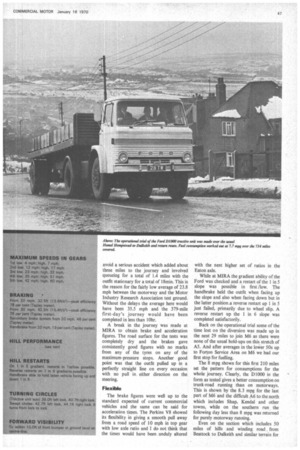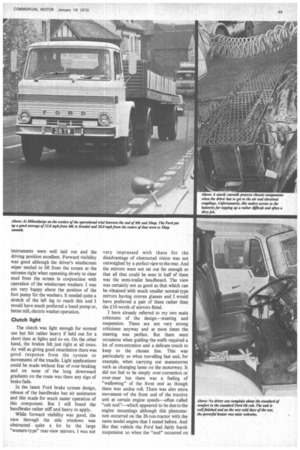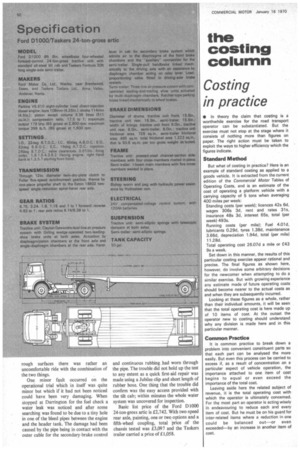Ford D1 000/Taskers 24-tan-gross artic
Page 48

Page 49

Page 50

Page 51

Page 52

If you've noticed an error in this article please click here to report it so we can fix it.
and operational
trial by Tony Wilding, MIMechE, MIRTE
AT ONE TIME fuel consumptions of around 10 or 11 mpg were common with 24-ton-gross vehicles—the maximum legal weight six years ago. And on some types of work and with some types of vehicle this sort of figure is still possible but with the demands for higher road speeds and better performance, modern vehicles generally compare unfavourably on CM fuel economy tests. So it was with the Perkins V8-engined Ford D1000 I have just tested at 24 tons gross. Performance was very good but fuel consumption worked out at 7.7 mpg over our 734-mile trial operational route with 9.5 and around 8.0 mpg the figures for good-class trunk-road and motorway sections.
These results are within the range that one has come to expect in recent years of a vehicle in this class. There are exceptions—such as 8.8 mpg from a Gardner 6 LXB in a 30-ton outfit—but tests of a 24-ton-gross eight-wheeler and a 26-ton-gross four-axle artic gave returns similar to those from the Ford. Ratios in the two-speed axle on the test vehicle were lower than absolutely necessary and this had a bearing on the results. They were 6.14 and 8.38 to 1 whereas I have completed the route—with its gradients of 1 in 5—with 5.57 and 7.60 to 1 with the same engine model, similar gearbox ratios and 26-ton-gross. If the higher gearing had been fitted fuel consumptions between five and 10 per cent better could have been expected.
Acceleration times and braking results were very good and the Ford was a comfortable vehicle to drive except that there was a rather "bumpy" ride from the suspension. Also, the steering needed close attention at times—particularly when making slight changes in direction at high speed—through a tendency to oversteer.
For my tests the Ford D1000 was coupled to a Taskers Formula single-axle semi-trailer and with the load just short of 16 tons on the platform it grossed exactly 24 tons with two men in the cab. With an extra man and small items of equipment, the plated weight was exceeded by 1.5cwt but each axle was within its plated limit although there was only 0.5cwt to spare in the case of that of the trailer. Set-route fuel consumption tests were carried out on the day before the start of the main run but the figures produced using a Petrometa fuel-measuring instrument were much too good to be true. This was confirmed after the first fill-up on the operational trial and the meter was shown to be something like 40 per cent out.
The two-day operational run went very well, fortunately with little effect from the weather; snow in Scotland on the day before the run and over most of England on the day after, would have given problems not only in trying to produce comparative figures with other vehicles. As it was, the only real effect from the conditions was on the early part of the first day when patches of ice on some parts of MI forced road speed to be kept below 50 mph for most of the first 50 miles. After this it was plain sailing except for a diversion on AS to avoid a serious accident which added about three miles to the journey and involved queueing for a total of 1.4 miles with the outfit stationary for a total of 18min. This is the reason for the fairly low average of 23.8 mph between the motorway and the Motor Industry Research Association test ground. Without the delays the average here would have been 35.5 mph and the 379-mile first-day's journey would have been completed in less than 10hr.
A break in the journey was made at MIRA to obtain brake and acceleration figures. The road surface for the tests was completely dry and the brakes gave consistently good figures with no marks from any of the tyres on any of the maximum-pressure stops. Another good point was that the outfit pulled up in a perfectly straight line on every occasion with no pull in either direction on the steering.
Flexible The brake figures were well up to the standard expected of current commercial vehicles and the same can be said for acceleration times. The Perkins V8 showed its flexibility in giving a smooth pull away from a road speed of 10 mph in top gear with low axle ratio and I do not think that the times would have been unduly altered with the next higher set of ratios in the Eaton axle.
While at MIRA the gradient ability of the Ford was checked and a restart of the 1 in 5 slope was possible in first /low. The handbrake held the outfit when facing up the slope and also when facing down but in the latter position a reverse restart up I in 5 just failed, primarily due to wheel slip. A reverse restart up the 1 in 6 slope was completed satisfactorily.
Back on the operational trial some of the time lost on the diversion was made up in the next 29 miles to join M6 as there were none of the usual hold-ups on this stretch of A5. And after averages in the lower 50s up to Forton Service Area on M6 we had our first stop for fuelling.
The 8 mpg shown for this first 210 miles set the pattern for consumptions for the whole journey. Clearly, the D1000 in the form as tested gives a better consumption on trunk-road running than on motorways. This is shown by the 8.3 mpg for the last part of M6 and the difficult A6 to the north which includes Shap, Kendal and other towns, while on the southern run the following day less than 8 mpg was returned for purely motorway running.
Even on the section which includes 50 miles of hills and winding road from Beattock to Dalkeith and similar terrain for
the first 57 miles of the second day, the consumption was reasonably good at 7.3 mpg before the expected big drop on the very hard part of A68-in this case down to 5.65 mpg. Also, as expected, the 40 mph "amble" down Al produced the best figure of the tripL).5 mpg.
Average speeds during the journey followed the usual pattern with just over 10hr needed for the 379-mile outward leg for an average of 37.4 mph and just over 9.5hr for the 355-mile southern journey for an average of 36.8 mph. With a total time on the road less than 20hr, average speed overall was 37.1 mph and, as already stated, overall fuel consumption was 7.7 mpg.
The usual times for climbing the four main hills on the route were taken on this test. On the first day, 10min 30sec were needed for the 4.25 miles from the Jungle Café to the summit of Shap. The lowest gear required was second/low for the maximum gradient of I in 9 when the minimum speed was 5 mph. For the general gradient of 1 in 11/12 after the "dip" following the first stage of Shap, second /high and third /low were used with the speed varying between 12 and 15 mph. Speed at the Jungle Cafe was 30 mph and we were slightly baulked by a slow .vehicle for a short distance on the first stage. A slow eight-wheeler descending gingerly to the "dip" prevented a proper "run" at the main hill but after this nothing got in our way and after the low speeds on the main climb 29 mph was reached at the summit.
Similar gears to those on Shap were needed for the 1.82-mile climb of Carter Bar on the second day. For the general gradient of 1 in 13/14, third/low was in use most of the time with one or two changes into second /high with the road speed between 13 and 15 mph. For the steepest section-1 in 9-second /high was satisfactory but the speed dropped to 10 mph before reaching 12 mph at the top. Speed at the bottom of the hill had been 40 mph and total time for the climb was 6min 55sec.
No run is possible for the climb of Riding Mill because of the sharp turn at the bottom. At this point road speed was 7 mph with second/high engaged, followed quickly by second/low and this gear was held up to the steepest point which has a gradient of 1 in 5. Here a change down4nto bottom was made-without changing the ratio in the axle at the same time. Speed dropped to less than 1 mph before increasing quickly to the maximum in the gear and a change into high axle ratio before the point where the hill eases off considerably. At this point road speed was 10 mph and the 0.6-mile climb had taken 3min 57sec. In my view, it would have been possible to climb Riding Mill with first /high as the lowest ratio but on such steep hills it is not practical or sensible to attempt "split" downward changes. It would have been better to go from second/high to first/high and then make an axle change into low if needed on the 1 in 5 part.
This sequence was used on Castleside Hill and first /high was adequate for the steepest gradient there which is fractionally less steep than 1 in 5. Minimum speed was 3 mph and after starting the climb at 30 mph the top was reached with 14 mph indicated, the 0.8-mile climb having taken 4min 27sec.
From a driving aspect the D1000 was very good. The seats were comfortable, instruments were well laid out and the driving position excellent. Forward visibility was good although the driver's windscreen wiper tended to lift from the screen at the extreme right when operating slowly to clear mud from the screen in conjunction with operation of the windscreen washers. I was not very happy about the position of the foot pump for the washers. It needed quite a stretch of the left leg to reach this and I would have much preferred a hand pump or, better still, electric washer operation.
Clutch light The clutch was light enough for normal use but felt rather heavy if held out for a short time at lights and so on. On the other hand, the brakes felt just right at all times. As well as giving good retardation there was good response from the system to movements of the treadle. Light applications could be made without fear of over-braking and on none of the long downward gradients on the route was there any sign of brake fade.
In the latest Ford brake system design, release of the handbrake has air assistance and this made for much easier operation of this component. But I still found the handbrake rather stiff and heavy to apply.
While forward visibility was good, the view through the side windows was obstructed quite a lot by the large "western-type" rear-view mirrors. I was not V cry impressed with these for the disadvantage of obstructed vision was not outweighed by a perfect view to the rear. And the mirrors were not set out far enough so that all that could be seen in half of them was the semi-trailer headboard. The view was certainly not as good as that which can be obtained with much smaller normal-type mirrors having convex glasses and I would have preferred a pair of these rather than the £10 worth of mirrors fitted.
I have already referred to my two main criticisms of the design—steering and suspension. These are not very strong criticisms anyway and at most times the steering was perfect. But there were occasions when guiding the outfit required a lot of concentration and a delicate touch to keep to the chosen line. This was particularly so when travelling fast and, for example, when carrying out manoeuvres such as changing lanes on the motorway. It did not feel to be simply over-correction or over-steer but there was a feeling of "wallowing" of the front end as though there was undue roll. There was also extra movement -of the front end of the tractive unit at certain engine speeds—often called "cab nod"--which appeared to be due to the engine mountings although this phenomenon occurred on the 26-ton-tractor with the same model engine that I tested before. And like that vehicle the Ford had fairly harsh suspension so when the "nod" occurred on
rough surfaces there was rather an uncomfortable ride with the combination of the two things.
One minor fault occurred on the operational trial which in itself was quite minor but which if it had not been noticed could have been very damaging. When stopped at Darrington for the fuel check a water leak was noticed and after some searching was found to be due to a tiny hole in one of the bleed pipes between the engine and the header tank. The damage had been caused by the pipe being in contact with the outer cable for the secondary brake control and continuous rubbing had worn through the pipe. The trouble did not hold up the test to any extent as a quick first-aid repair was made using a Jubilee clip and short length of rubber hose. One thing that the trouble did confirm was the easy access provided with the tilt cab; within minutes the whole water system was uncovered for inspection.
Basic list price of the Ford D1000 24-ton-gross artic is £2,742. With two-speed rear axle, painting, one or two options and a fifth-wheel coupling, total price of the chassis tested was £3,097 and the Taskers trailer carried a price of £1,058.
































































































